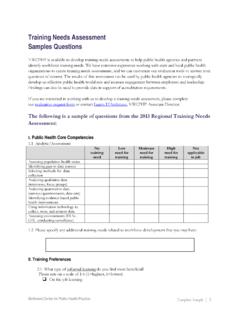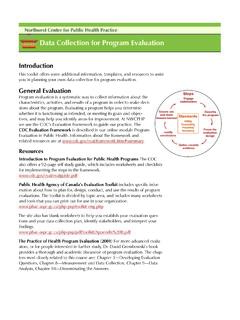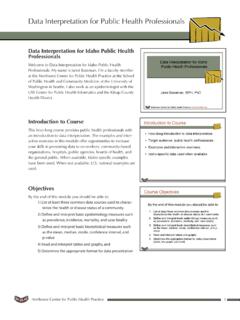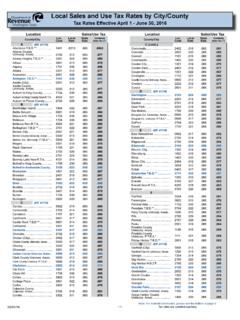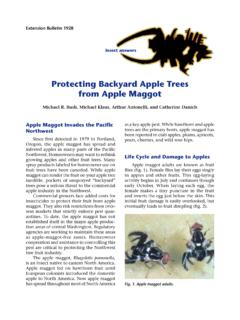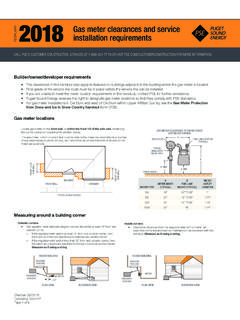Transcription of Measuring Risk in Epidemiology Transcript
1 TranscriptNorthwest Center for Public Health PracticeMeasuring Risk in Epidemiology1abcdMeasuring Risk in EpidemiologyWelcome to Measuring Association and Risk in Epidemiology . My name is Jim Gale. I am professor emeritus in the Department of Epidemiology at the University of Washington School of Public Health and Community Medicine. I spent 12 years as a local health officer in Kittitas County, Washington, and have also been a US Public Health Service Epidemic Intelligence Service officer. About this ModuleThis module and others in the Epidemiology series from the Northwest Center for Public Health Practice are intended for people working in the field of public health who are not epidemiologists but would like to increase their familiarity with and understanding of the basic terms and concepts used in Epidemiology .
2 Before you go on with this module we recommend that you become familiar, if you haven t already, with the material presented in the following modules, which you can find on the Center s Web site: What Is Epidemiology in Public Health? Data Interpretation for Public Health Professionals Study Types in Epidemiology It is particularly important to understand the concepts of rates, ratios, and measures of disease frequency, such as incidence rates and death rates. These concepts are covered in the modules What is Epidemiology in Public Health Practice? and Data Interpretation for Public Health Professionals. If you want to review definitions of epidemiological terms, you may access the glossary at any time from the attachments link at the top of the screen.
3 You can also find the Transcript in the attach-ments. You may want to print a copy now and make notes on it as you go through the ObjectivesIn this module we will explore the meaning of risk and association and their relationship to incidence rates in Epidemiology . We will also look at measures of risk and their use and limitations in considering causal relationships. By the end of this 45-minute module you should be able: To define risk as it is used in public health practiceTranscriptNorthwest Center for Public Health PracticeMeasuring Risk in Epidemiology2abcd To identify measures of association and risk as they are used in Epidemiology To interpret relative risk and odds ratios and be familiar with their calculation using 2x2 tables, and To interpret the following measures of risk differences: attributable risk, popula-tion attributable risk, and population attributable risk RiskEpidemiologists use the term risk to mean the probabil-ity of an outcome (often a negative outcome) in a speci-fied period of time.
4 In Epidemiology , risk usually implies a quantifiable concept, such as the risk of dying or the risk of a heart attack, rather than a more general concept such as the risk of offending someone by speaking frankly. In this module, I will use risk, probability, and likelihood interchangeably, since they re measured the same way. Why is it important to know about risk? In the practice of public health, we are faced with many choices. A quan-titative estimate of risk is useful in making decisions about a course of action or intervention as well as how to allo-cate finite resources of time and vs. AssociationIn Epidemiology , an association means a correlation, often between an exposure and an d like to pause for a moment to talk about correla-tion and causation.
5 Correlation is the situation in which two or more variables, in this case exposure and outcome, change at the same time. For example, as exposure to the sun increases, the incidence of some types of cancer increases. It s important to remember that just because both variables change, it does not mean that one causes the other to change. In other words, correlation does not equal causation. Some other unknown factor may be caus-ing both the exposure and the outcome to the degree to which an association might be causal, occupies a great deal of an epidemiologist s thinking and effort. Where an association is thought to be causal, as in the association between smoking and lung cancer, we often use the term risk factor in referring to the exposure we are of association refer to specific mathematical expressions that measure the degree to which an exposure, such as exercise or smoking, is associated with an outcome of interest, such as health status or disease.
6 Some measures of associa-TranscriptNorthwest Center for Public Health PracticeMeasuring Risk in Epidemiology3abcdtion we ll explore later in this module are relative risk, odds ratio, attributable risk, risk difference, population attributable risk, and population attributable risk percent. Now we ll pause for the first of several interactive exercises that will allow you to answer questions about the material we have just covered. Please note that the exercises can take several seconds to , Proportions, and RatesBefore we go any further, let s review three terms we ll be using in this module: ratios, proportions, and rates. A ratio compares two dissimilar things by dividing one quantity by another.
7 For example, say a group of people has 5 women and 7 men. The ratio of women to men is 5 to 7. We can also express the relationship of women to the entire group as a proportion, or a percentage, of the total number of people. A proportion or a percentage is a special kind of ratio, because the group affected, or the numerator, must come out of the population at risk, which is the denominator. For example, our group contains 12 people. The proportion of women in the group is 5/12. We can also express this fraction as 42 per 100, or 42%. The value of a proportion never exceeds 1, or 100 rate is also written as a numerator and a denominator, but a rate has an element of time. You will often see person-years used as a denominator in calculating rates.
8 A multiple of 10 is often used to create a numerator with at least one number to the left of the decimal point. For example, the risk of dying last year from stomach cancer may be However, for most people, it s easier to think about this rate when it is expressed as deaths per 100,000 per year. Rates can be written in several ways. For example, the rate of 8 deaths per 100,000 from suicide in 20 to 24 year olds in Oregon in 1995 could also be expressed in these you want to review the arithmetic of counts, numerators, denominators, ratios, proportions, and rates, they are well covered in slides 11 through 14 in the module Data Interpretation for Public Health Professionals. Before we go on to look at measures of risk, or measures of association as we usually call them, we should also look at a tool often used in calculating these measures, the 2 by 2 table.
9 TranscriptNorthwest Center for Public Health PracticeMeasuring Risk in Epidemiology4abcd2 x 2 TablesEpidemiologists use 2 by 2 tables, which are also some-times called contingency tables, to record and analyze the relationship between variables. Since we re often compar-ing two exposures and two states of illness, the 2x2 table has four cells, or options. The usual format of the table is to list the outcomes or disease categories in the verti-cal columns, and the exposures, or attributes, in the table rows. In this example, we ll label the exposure rows exposed and non-exposed, and we ll label the outcome columns, sick and well. Just for this example, we ll represent the counts in the four cells as a, b, c, and d.
10 A key point to remember about 2x2 tables is that the data in the cells are actual counts, not you go through the module, you ll see how to use a 2x2 table to calculate vari-ous measures of association and Sources for Calculating RiskAs I mentioned before, risk is the same as the probabil-ity, chance, or likelihood that something will happen. Risks can be inferred from published death rates, from incidence rates from an existing disease registry, such as a cancer registry, or from attack rates from an outbreak investigation. But more frequently special studies, such as cohort studies, must be carried out to determine these rates in populations that are or are not subject to specific exposures.


